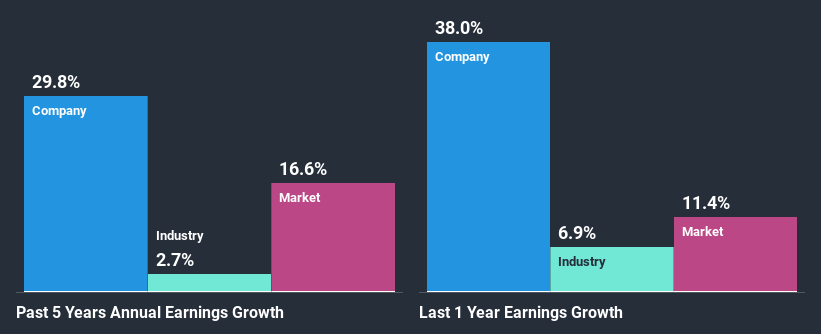Kri-Kri Milk Industry S.A.'s (ATH:KRI) Stock Been Rising: Are Strong Financials Guiding The Market?

Most readers would already know that Kri-Kri Milk Industry's (ATH:KRI) stock increased by 9.4% over the past three months. Since the market usually pay for a company’s long-term financial health, we decided to study the company’s fundamentals to see if they could be influencing the market. Specifically, we decided to study Kri-Kri Milk Industry's ROE in this article.
ROE or return on equity is a useful tool to assess how effectively a company can generate returns on the investment it received from its shareholders. Put another way, it reveals the company's success at turning shareholder investments into profits.
Check out our latest analysis for Kri-Kri Milk Industry
How Do You Calculate Return On Equity?
Return on equity can be calculated by using the formula:
Return on Equity = Net Profit (from continuing operations) ÷ Shareholders' Equity
So, based on the above formula, the ROE for Kri-Kri Milk Industry is:
22% = €17m ÷ €74m (Based on the trailing twelve months to September 2020).
The 'return' is the income the business earned over the last year. Another way to think of that is that for every €1 worth of equity, the company was able to earn €0.22 in profit.
What Has ROE Got To Do With Earnings Growth?
So far, we've learned that ROE is a measure of a company's profitability. Based on how much of its profits the company chooses to reinvest or "retain", we are then able to evaluate a company's future ability to generate profits. Assuming everything else remains unchanged, the higher the ROE and profit retention, the higher the growth rate of a company compared to companies that don't necessarily bear these characteristics.
A Side By Side comparison of Kri-Kri Milk Industry's Earnings Growth And 22% ROE
To start with, Kri-Kri Milk Industry's ROE looks acceptable. Further, the company's ROE compares quite favorably to the industry average of 8.2%. Probably as a result of this, Kri-Kri Milk Industry was able to see an impressive net income growth of 30% over the last five years. However, there could also be other causes behind this growth. For example, it is possible that the company's management has made some good strategic decisions, or that the company has a low payout ratio.
As a next step, we compared Kri-Kri Milk Industry's net income growth with the industry, and pleasingly, we found that the growth seen by the company is higher than the average industry growth of 4.9%.

The basis for attaching value to a company is, to a great extent, tied to its earnings growth. What investors need to determine next is if the expected earnings growth, or the lack of it, is already built into the share price. Doing so will help them establish if the stock's future looks promising or ominous. One good indicator of expected earnings growth is the P/E ratio which determines the price the market is willing to pay for a stock based on its earnings prospects. So, you may want to check if Kri-Kri Milk Industry is trading on a high P/E or a low P/E, relative to its industry.
Is Kri-Kri Milk Industry Using Its Retained Earnings Effectively?
Kri-Kri Milk Industry's three-year median payout ratio is a pretty moderate 40%, meaning the company retains 60% of its income. This suggests that its dividend is well covered, and given the high growth we discussed above, it looks like Kri-Kri Milk Industry is reinvesting its earnings efficiently.
Besides, Kri-Kri Milk Industry has been paying dividends over a period of six years. This shows that the company is committed to sharing profits with its shareholders.
Summary
In total, we are pretty happy with Kri-Kri Milk Industry's performance. In particular, it's great to see that the company is investing heavily into its business and along with a high rate of return, that has resulted in a sizeable growth in its earnings. If the company continues to grow its earnings the way it has, that could have a positive impact on its share price given how earnings per share influence long-term share prices. Not to forget, share price outcomes are also dependent on the potential risks a company may face. So it is important for investors to be aware of the risks involved in the business. To know the 2 risks we have identified for Kri-Kri Milk Industry visit our risks dashboard for free.
When trading Kri-Kri Milk Industry or any other investment, use the platform considered by many to be the Professional's Gateway to the Worlds Market, Interactive Brokers. You get the lowest-cost* trading on stocks, options, futures, forex, bonds and funds worldwide from a single integrated account. Promoted
Valuation is complex, but we're here to simplify it.
Discover if Kri-Kri Milk Industry might be undervalued or overvalued with our detailed analysis, featuring fair value estimates, potential risks, dividends, insider trades, and its financial condition.
Access Free AnalysisThis article by Simply Wall St is general in nature. It does not constitute a recommendation to buy or sell any stock, and does not take account of your objectives, or your financial situation. We aim to bring you long-term focused analysis driven by fundamental data. Note that our analysis may not factor in the latest price-sensitive company announcements or qualitative material. Simply Wall St has no position in any stocks mentioned.
*Interactive Brokers Rated Lowest Cost Broker by StockBrokers.com Annual Online Review 2020
Have feedback on this article? Concerned about the content? Get in touch with us directly. Alternatively, email editorial-team (at) simplywallst.com.
About ATSE:KRI
Kri-Kri Milk Industry
Operates in the dairy industry in Greece and internationally.
Flawless balance sheet with reasonable growth potential and pays a dividend.
Market Insights
Community Narratives


